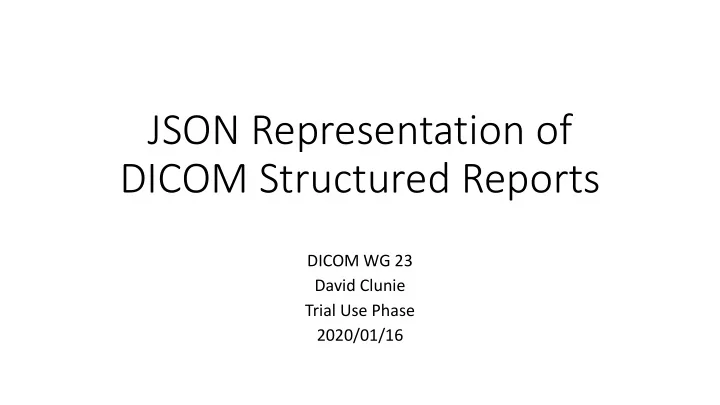

JSON Representation of DICOM Structured Reports DICOM WG 23 David Clunie Trial Use Phase 2020/01/16
http://medium.com/adhive/disruptive-ai-controlled-advertising-cd90a07452cb
Annotation interoperability matters now • Previously: • little incentive to annotate • few tools to create or view annotations • annotation interoperability was a low priority for product managers • presentation rather than semantics were the priority for annotation tools • Now: • semantic annotations have (real monetary) value beyond primary use case • recognition of existence of unanticipated re-use cases • annotations are expensive to create/recreate retrospectively • more expensive to process if proprietary rather than OTS standard • AI-generated annotations need to be interoperable for display • “interactive” AI requires interoperable annotation exchange • AI vendors unlikely to be the same as scanner/PACS vendors – mix and match
DICOM SR and AI • DICOM SR is a generic solution for: • fundamental encoding of measurements, categorical results, using codes and referencing images, waveforms as well as spatial and temporal coordinates • reusable sub-templates for specific scenarios that are common to different use cases and applications • generic root level templates for non-specific measurements (e.g., TID 1500) • linking other objects related to results and measurements (such as SEG, Parametric Map and RWVM) • Specific templates for: • traditional CAD applications that are relevant to AI • traditional human operator measurements that may now be made by AI
DICOM SR and the developer • Traditional DICOM SR encoding requires use of a toolkit and an API with a non-trivial learning curve (binary encoding intractable by hand) • AI algorithm developer may not need to know about the “composite context” (patient/study/series +/- workflow metadata) of the encounter • Impedance mismatch between • PACS-orientated “DICOM image in, DICOM SEG + SR out” • Algorithm-developer orientated “PNG in, PNG + JSON out” • Even XML is deemed excessive/too complicated by AI developer community • DICOMweb JSON encoding is also intractable for SR, since it is hexadecimal tag, individual data element orientated (no SR content item abstraction)
Goals for Simplified DICOM SR in JSON • Full-fidelity round trip with actual DICOM SR for all constructs (any template) • Simple (enough to hand write or copy from examples) • Compact (even terse) • Understandable (relatively) • Unambiguous (easily parsable) • Leverage any existing actual or de facto JSON or evolving AI standards • Platform independent • Capable of encoding extracts separated from composite context (such as without “header” rather than content tree, image library, etc., which could be added by separate tool/pass)
Non-Goals for Simplified DICOM SR in JSON • Not an alternative/competitor to existing PS3.18 Annex F JSON for non-SR objects • Not an alternative/competing persistent form to be serialized and stored, as opposed to binary DICOM SR stored in PACS/VNA • Not an abstraction of template-specific concepts or alternative information models for similar content • No template-specific constraints or optimizations • Not a means for defining a new validation mechanism for SR content (template-defined), but does not prohibit it
Pipeline to add missing stuff to JSON Lesion Size, + Image Library + Lesion + Composite Coordinates and and Evidence Identifiers Context Image Reference Sequences DICOM Image Patient-Study AI Algorithm Lesion Manager PACS Aware System Aware System
Design Decisions – Business Names • No hexadecimal numbers for “header” attributes – leverage DICOMweb JSON encoding but with PS3.6 keywords rather than numeric tags • Abstract the content items (i.e., name-value pairs), as if they were attributes, rather than exposing their component attributes • No obscure alphanumeric codes in content tree – use “business names” concept from Green CDA (not dissimilar to JSON-LD) • Codes are defined in separate “business names” JSON file that acts as a dictionary – do not need to be standardized (but may be in future, like keywords)
Design Decisions – JSON Structure • Use JSON Objects where identity is important but not order • Use business name as name of JSON Object’s name-value pair • Use JSON Arrays to preserve order • Use JSON Arrays to allow sibling JSON Objects with same name • Use a JSON Array to encode children • Collapse unnecessary JSON Arrays into single value when possible for business names and top level data elements • Omit data element VR if it can be found in dictionary or business name file • Omit explicit value type and relationship type if they can be deduced from context, or defined in the separate business names file • Add annotations (specific object names starting with “_” symbol) to content item specific attributes, and to provide target and source for by-reference relationships • Use keywords for well known UIDs, e.g., Storage SOP Classes
Example 1 – hexdump of the original (partial)
Example 1 – dcsrump of the original
Example 1 – JSON of the content tree (only)
Example 1 – JSON of result only (no coords)
Example 1 –Business Names file (partial)
Keywords for UIDs
Out of Scope (for this development cycle) • A DICOMweb API to transform JSON SR to/from the standard binary DICOM SR persistent form, though experimental media types are defined (in a WADO-RS or STOW-RS “application/dicom+json” like manner, e.g., “application/x-dicom-sr+json”) • A DICOMweb API to access, create or modify the DICOM SR content tree abstraction (cf. the existing RetrieveMetadata individual DICOM attribute level access) • A DICOMweb API to create and manage individual (or sets of) annotations separately from the storage/retrieval of entire DICOM SR object • A DICOMweb API to perform/manage the various steps of the authoring pipeline that adds lesion management, image references and descriptions, and patient/study/series/workflow composite context
Recommend
More recommend